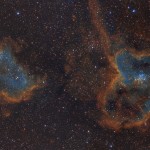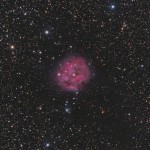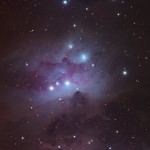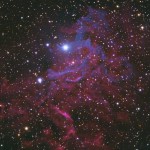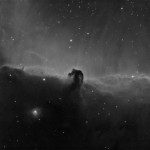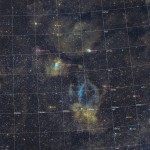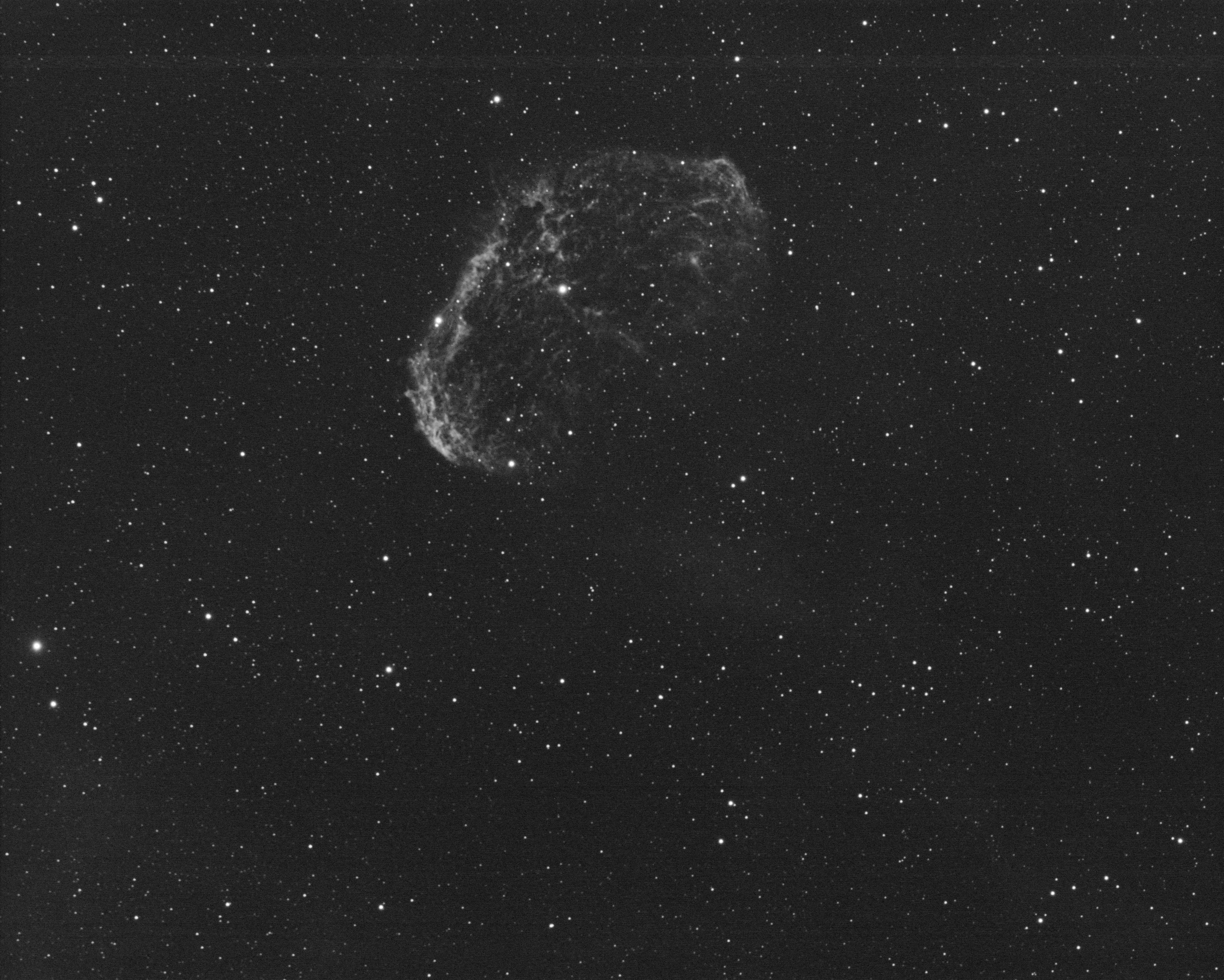I thought it would be fun to take an older image, reprocess it, and crop into smaller sections that would put a new spin on a very commonly imaged object. Hope you like them. I won’t reveal what the object is until later.
- IC 1396 – The Elephant Trunk
FSQ-106ED
Apogee U16
AP900GTO Mount
MMOAG w/ ST-402
9.5 Hours Total Exposure
Baader Ha, O[III], S[II] filters
The Elephant’s Trunk nebula is a concentration of interstellar gas and dust within the much larger ionized gas region IC 1396 located in the constellation Cepheus about 2,400 light years away from Earth.[1] The piece of the nebula shown here is the dark, dense globule IC 1396A; it is commonly called the Elephant’s Trunk nebula because of its appearance at visible light wavelengths, where there is a dark patch with a bright, sinuous rim. The bright rim is the surface of the dense cloud that is being illuminated and ionized by a very bright, massive star that is just to the west of IC 1396A. (In the Figure above, the massive star is just to the left of the edge of the image.) The entire IC 1396 region is ionized by the massive star, except for dense globules that can protect themselves from the star’s harsh ultraviolet rays.
The Elephant’s Trunk nebula is now thought to be a site of star formation, containing several very young (less than 100,000 yr) stars that were discovered in infrared images in 2003. Two older (but still young, a couple of million years, by the standards of stars, which live for billions of years) stars are present in a small, circular cavity in the head of the globule. Winds from these young stars may have emptied the cavity.
The combined action of the light from the massive star ionizing and compressing the rim of the cloud, and the wind from the young stars shifting gas from the center outward lead to very high compression in the Elephant’s Trunk nebula. This pressure has triggered the current generation of protostars.[2]
- Heart and Soul Mosaic
The Heart Nebula, IC 1805, Sh2-190, lies some 7500 light years away from Earth and is located in the Perseus Arm of the Galaxy in the constellation Cassiopeia. This is an emission nebula showing glowing gas and darker dust lanes. The nebula is formed by plasma of ionized hydrogen and free electrons.
The very brightest part of this nebula (the knot at the right) is separately classified as NGC 896, because it was the first part of this nebula to be discovered.
The nebula’s intense red output and its configuration are driven by the radiation emanating from a small group of stars near the nebula’s center. This open cluster of stars known as Melotte 15 contains a few bright stars nearly 50 times the mass of our Sun, and many more dim stars that are only a fraction of our Sun’s mass. The cluster used to contain a microquasar that was expelled millions of years ago.
Description courtesy of Wikipedia
Soul Nebula (Sharpless 2-199, LBN 667) is emission nebulae in Cassiopeia. Several small open clusters are embedded in the nebula: CR 34, 632, and 634[citation needed] (in the head) and IC1848 (in the body). The object is more commonly called by the cluster designation IC1848.
Small emission nebula IC 1871 is present just left of the top of the head, and small emission nebulae 670 and 669 are just below the lower back area.
This complex is the eastern neighbor of IC1805 (Heart Nebula) and the two are often mentioned together as the “Heart and Soul”.
- IC 5146 – The Cocoon Nebula
IC 5146 (also Caldwell 19, Sh 2-125, and the Cocoon Nebula) is a reflection[1]/emission[2] nebula and Caldwell object in the constellation Cygnus. The NGC description refers to IC 5146 as a cluster of 9.5 mag stars involved in a bright and dark nebula. The cluster is also known as Collinder 470.[3] It shines at magnitude +10.0[4]/+9.3[2]/+7.2.[5] Its celestial coordinates are RA 21h 53.5m, dec+47° 16′. It is located near the naked-eye star Pi Cygni, the open cluster NGC 7209 in Lacerta, and the bright open cluster M39.[1][4] The cluster is about 4,000 ly away, and the central star that lights it formed about 100,000 years ago;[6] the nebula is about 12 arcmins across, which is equivalent to a span of 15 light years.[5] When viewing IC 5146, dark nebula Barnard 168 (B168) is an inseparable part of the experience, forming a dark lane that surrounds the cluster and projects westward forming the appearance of a trail behind the Cocoon.
- The Running Man NGC 1977
NGC 1973/5/7 is a reflection nebula 1/2 degree northeast of the Orion Nebula. The three NGC objects are divided by darker regions. It is also called The Running Man Nebula and Sharpless Catalog 279.
This object was named ‘The Running Man Nebula’ by Texas Astronomical Society member Jason Ware. Approximately 20 years ago his down stairs neighbor looked at the object and said it looked like a running man. He brought this up a TAS club meeting and the name stuck. Now widely accepted as ‘The Running Man’.
- IC 405 – The Flaming Star
IC 405 (also known as the Flaming Star Nebula, SH 2-229, or Caldwell 31) is an emission/reflection nebula[1] in the constellation Auriga, surrounding the bluish star AE Aurigae. It shines at magnitude +6.0. Its celestial coordinates are RA 05h 16.2m dec +34° 28′.[2] It surrounds the irregular variable star AE Aurigae and is located near the emission nebula IC 410, the open clusters M38 and M36, and the naked-eye K-class star Hassaleh. The nebula measures approximately 37.0′ x 19.0′, and lies about 1,500 light-years away.[2] It is believed that the proper motion of the central star can be traced back to the Orion’s Belt area.[2] The nebula is about 5 light-years across.[1]
- AP130EDT f/6.3 Apogee A694 Atlas EQ-G 5x20min Ha
- M52, NGC 7635 The Bubble Nebula, SH2-157 The Lobster Claw Nebula, SH2-161
- (Earlier Work) Annotated
This area is rich in diversity offering the Open Cluster M52, Emission Nebula SH2-157 aka The Lobster Claw Nebula as well as SH2-161. Also included is the more famous Bubble Nebula NGC 7635.
Imaged from my backyard outside Pittsburgh, PA.
Telescope: Tak FSQ-106ED
CCD: Apogee U16
Mount: AP900GTO3
Exposure Time: H-Alpha = 14x20min, O[III] = 9x20min, S[II] = 10x20min
Total Exposure Time = 11 Hours
The A694 finally saw first light after an extended bought of bad weather and other personal issues. This is a single 20 minute frame without any bias, dark, or flat calibration taken through an AP130EDT f/8 reduced to f/6.35 with the AP 0.75X reducer all riding on an Atlas mount.
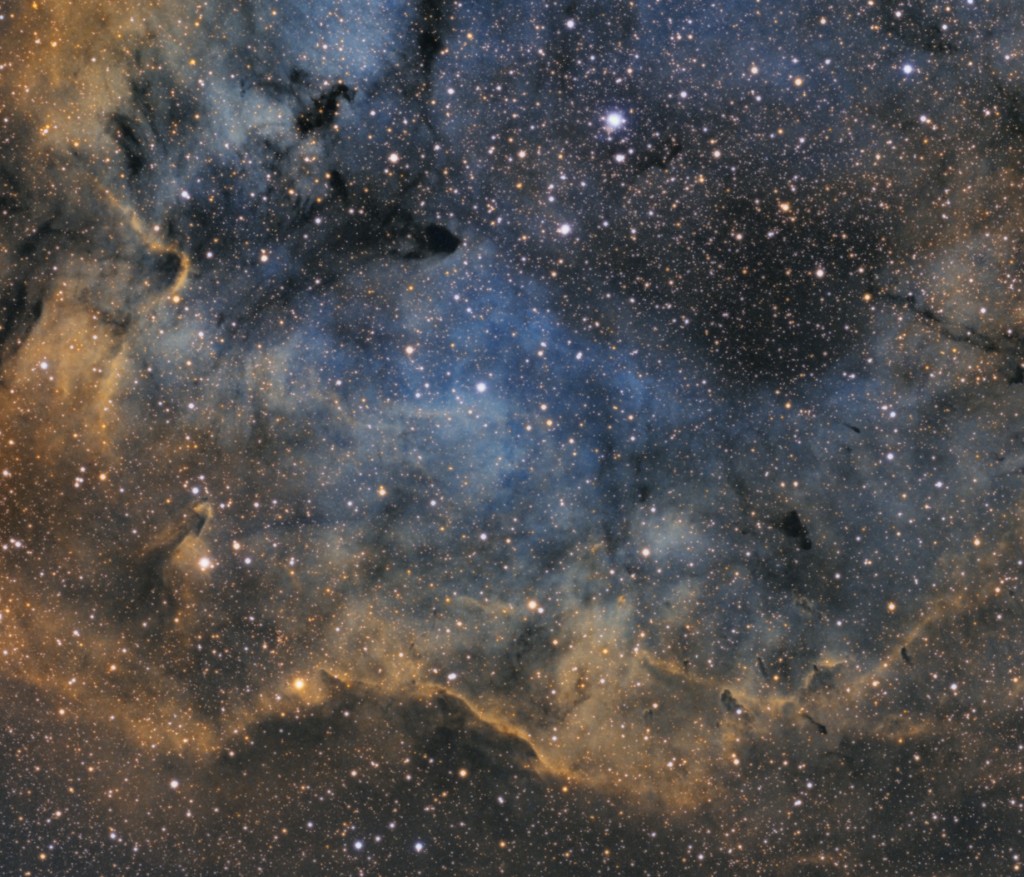
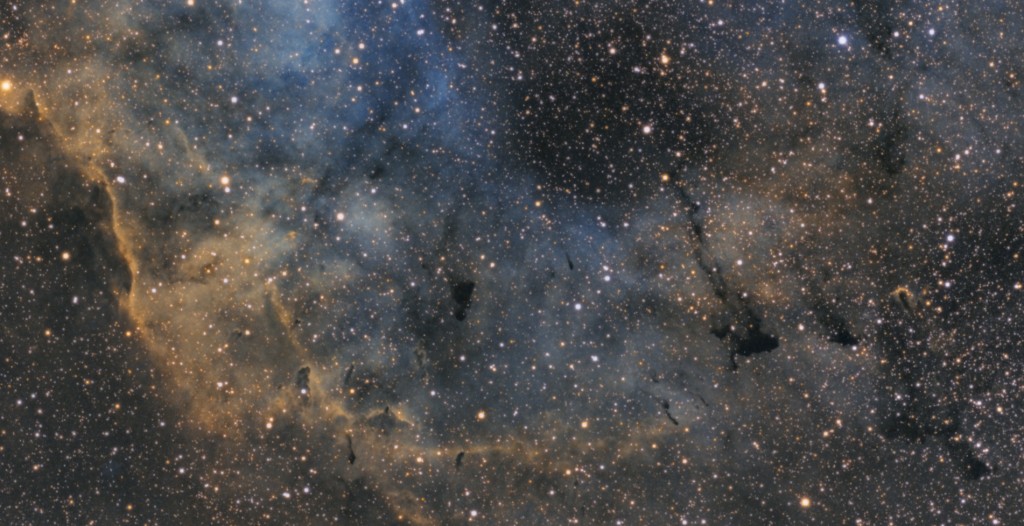
![NGC 2175 AP130EDT w/ 0.75X Reducer (f/6.3) Apogee Ascent A694 CCD Baader Narrowband Filters 7x20min Ha 10x20min O[III] 9x20min S[II]](http://www.celestial-imaging.com/wp-content/uploads/2014/04/NGC-2175-Crop.jpg)

